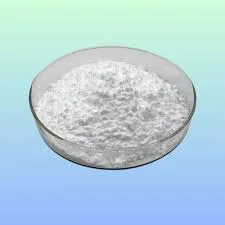
Nov . 01, 2024 11:31 Back to list
Exploring the Chemical Structure and Properties of HPMC in Applications
HPMC, or Hydroxypropyl Methylcellulose, is a widely utilized cellulose ether that finds applications across various industries, including pharmaceuticals, food, construction, and cosmetics. Its unique chemical structure enables it to function effectively as a thickening agent, stabilizer, and film-forming agent, making it indispensable in both formulation and end-product performance.
The chemical structure of HPMC is derived from cellulose, which is a natural polymer predominantly found in the cell walls of plants. To create HPMC, cellulose is modified through a process involving propylene oxide and methyl chloride. This modification introduces hydroxypropyl and methyl groups onto the cellulose backbone, which enhances its solubility in water and increases its functionality.
.
In the food industry, HPMC serves as a food additive, often designated by the E number E464. It is used to improve texture, retain moisture, and stabilize emulsions in products such as sauces, dressings, and bakery goods. Its versatility allows manufacturers to create low-fat and gluten-free products while maintaining desirable mouthfeel and shelf stability.
hpmc chemical structure

In construction, HPMC is a critical ingredient in polymer-modified cement systems. Its inclusion enhances workability and prevents crack formation, making it essential in creating high-performance mortars and plasters. The water-retaining properties of HPMC ensure that cement mixtures maintain adequate moisture during curing, fostering improved strength and durability.
The cosmetic industry also benefits from HPMC's unique properties, which help in formulating stable emulsions and gel-like products. It acts as a thickener in lotions and creams, giving them a pleasing texture and improving their application characteristics.
Furthermore, the environmental profile of HPMC is noteworthy. As a non-toxic and biodegradable polymer, it aligns with the growing demand for sustainable and eco-friendly materials. This makes HPMC not only an effective but also a responsible choice for manufacturers looking to reduce their environmental impact.
In conclusion, the chemical structure of HPMC contributes to its multifunctionality across various industries. With its myriad applications and favorable properties, HPMC continues to be a vital ingredient in enhancing product performance, making it an essential component in modern formulation science.
-
Unlocking the Benefits of HPMC Products: A Gateway to Versatile Applications
NewsAug.07,2025
-
Unleashing the Potential of HPMC Ashland: A Comprehensive Look
NewsAug.07,2025
-
Tile Bonding Cellulose: The Key to Superior Adhesion and Durability
NewsAug.07,2025
-
Hydroxypropyl Methylcellulose Powder: The Versatile Component in Modern Pharmaceuticals
NewsAug.07,2025
-
Hydroxyethyl Cellulose: The Versatile Solution for Various Industries
NewsAug.07,2025
-
Hydroxyethyl Cellulose (HEC): The Versatile Polymer for Various Applications
NewsAug.07,2025







